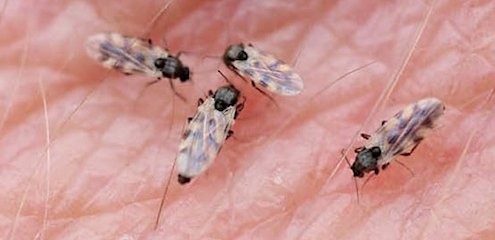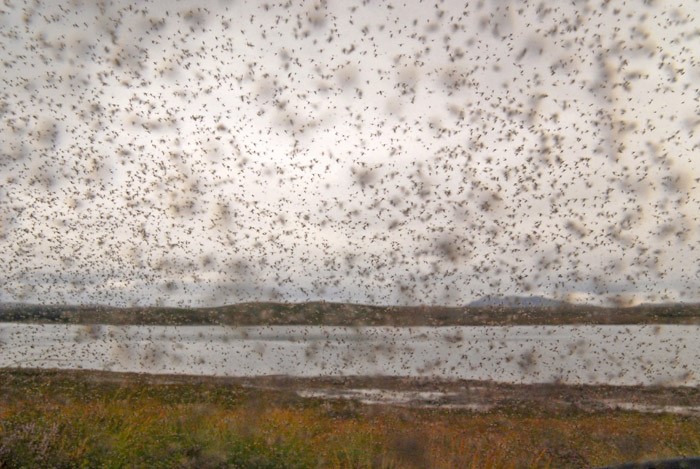Midges…complete and utter nuisances. That’s what most people tend to say.
Well…I’ve heard quite a few individuals use more colourful language than that, but that’s the gist of most people’s views on this small flying insect that occupies the Highlands. This view is commonly expressed whilst people flap their hands around as if they’re aiming to actually launch off and flee the plague of midges.
In the bible there is reference to a plague of locust but this past week it is the midge numbers that have been of biblical proportions, causing people to look like they have moustaches and tattoos. In the five years that I’ve been reindeer herding last week was by far the worst that I’ve ever seen the midges.
During this past week I also found that the term midge can get lost in translation! We recently had a visitor who complained about being attacked by midgets. It’s amazing the difference one letter in a sentence can make!

It was during the latest inundation of midge attacks that I found myself asking: Where do these midges even live? Why are they biting us? How long do they live? Well, look no further folks…let’s rattle out some midge facts.
• Midges have a life span of around one month. Although adults are only capable of flight for a short portion of that time.
• Midges lay their eggs in wet soil, bogs, mires and the soggy surrounding landscape.
• In the U.K. there is 2-3 batches of midge eggs per year. The first batch is in May or June depending on warmth and moisture levels. A second occurs in late July or early August. And if the season is a warm one, a third batch can occur in September.
• In the U.K. alone there are more than 500 species of non-biting midges, and more than 150 species of biting midges. Most of these are found in Scotland, however they can also be found in Northern England and Northern Wales.
• Only the female midges bite. The male and female midges survive upon sugary food such as plant nectar. However, the females need a protein rich meal of fresh blood in order to mature their eggs. They get this from both birds and mammals, with the majority of blood coming from cattle, sheep and deer.
• Female midges tend to bite in close proximity to their breeding site and rarely go further than 1km away (cough, cough, Utsi bridge).
• Once they’ve found a blood source, midges emit pheromones and summon all their buddies to come on over, hence the swarming.
• They have short and sharp mandibles to pierce the skin of mammals and then they increase the blood flow via histamines in their saliva. This is what causes the wound to swell afterwards.
• Low light spurs their feeding habits so they’re most active at dawn and dusk.
• It takes a midge five minutes of feeding to become engorged.
• Mild and wet winters usually means a bigger midge season. Moreover, a very cold winter can also mean a bigger midge season. In 2010 the prolonged freezing conditions in Scotland reduced the number of natural predators such as bats and birds, meaning more midges.
• It is estimated that midges cost the Scottish tourism industry around £268 million per year in lost visits.
• On the Isle of Rum, folk lore says that as punishment for improperly burying a body, a gravedigger was stripped, tied to a post and left outside for the midges to feast on. They did kill him, eventually.
• Rumour has it that pomegranate skin, marmite, lavender and charcoal are all deterrents.
• They’re attracted to the CO2 that us animals produce. Some people are more attractive than others due to a combination of specific body odour and temperature. They are also more attracted to dark coloured clothing than light coloured clothing.
• There is a midge forecast, detailing how torrential the midge downpour is across Scotland, which can be located at https://www.smidgeup.com/midge-forecast/.

So, there you have it. They say knowledge is power, but I’m not sure this knowledge will stop you being attacked by these small critters, but at least it may give you some happiness to know that you’re playing a part in a midge’s life cycle. Bah, who am I kidding? Probably not! But you may get some happiness in knowing that at least you’re not a midge.

References:
https://www.lifesystems.co.uk/news/45-facts-about-the-highland-midge
